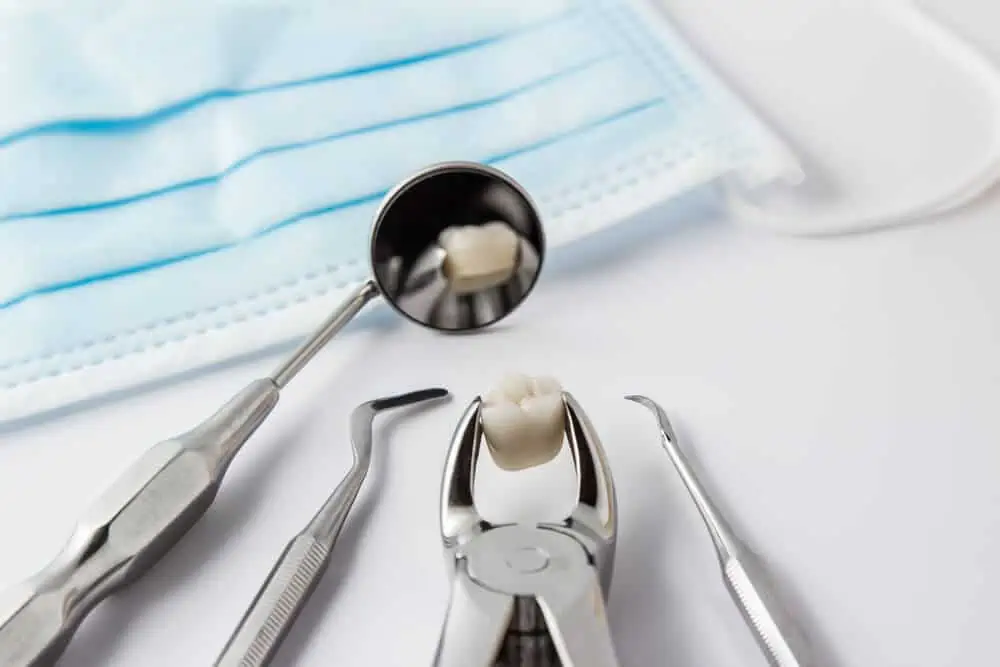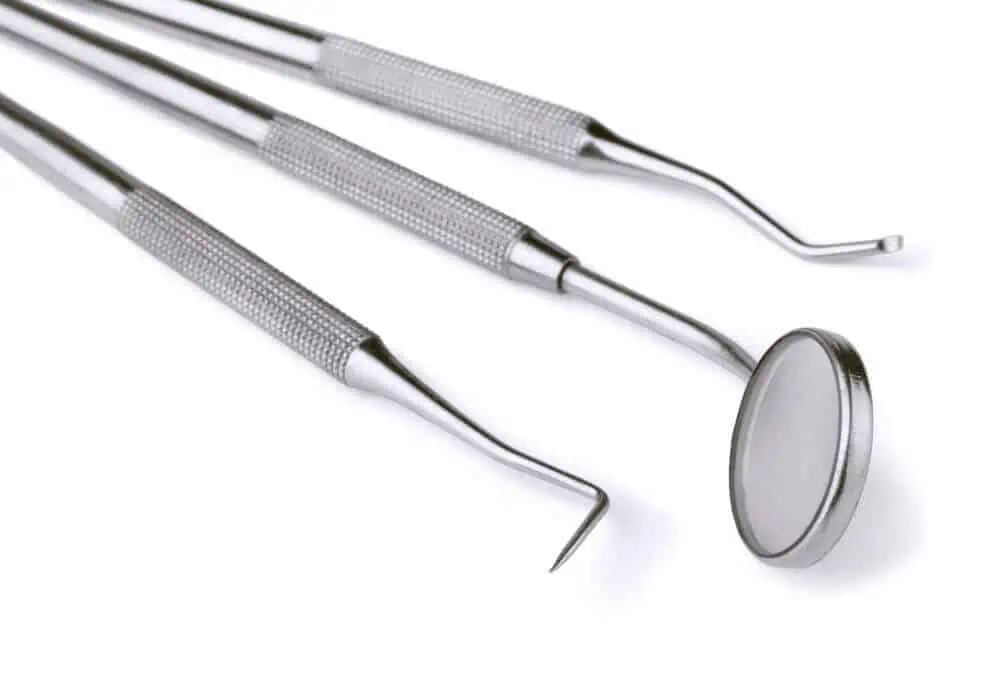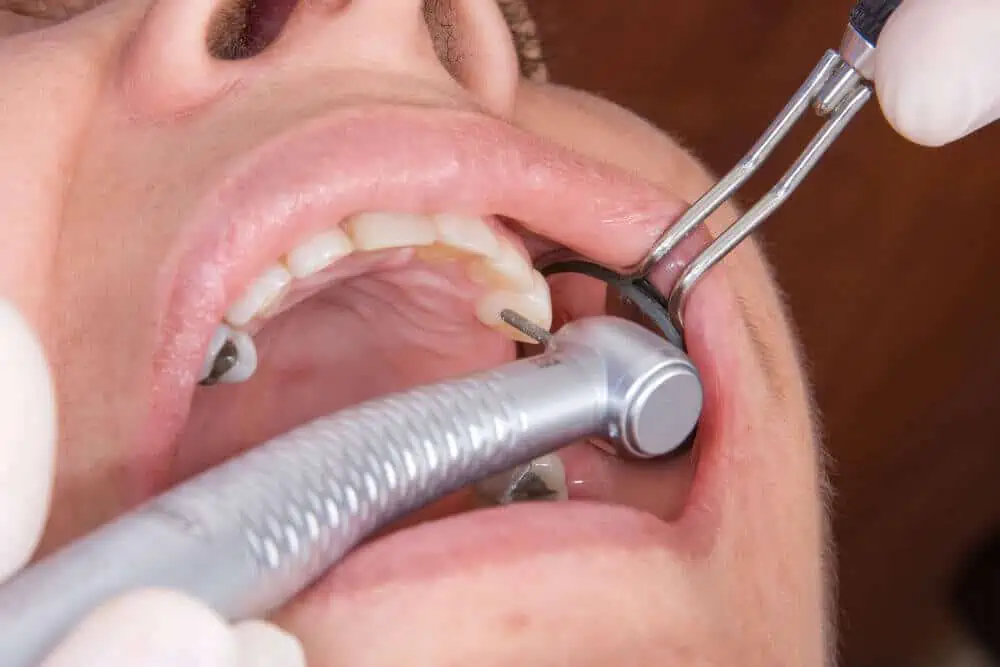Are you one of those anxious patients who are scared of dental tools? Well, you’re not alone. Dental anxiety is real.
Research indicates that dental anxiety is often due to scary-looking dental tools and is the primary reason some people avoid visiting their dentist. Of course, this adversely affects their dental health.
We believe that arming yourself with information is one of the best ways to combat anxiety.
Here, we’ll talk about the basic dental instruments and answer the following questions:
- What tools do dentists use?
- Which instruments clean teeth?
- Which dental assisting tools are used for fillings?
Let’s get started.
In This Article
A word of caution!
The dentist equipment mentioned below is not for use at home. These tools are meant only for professional use, and you might seriously injure yourself while trying to use them on your own.

What are the different tools used by a dentist?
From mirrors to probes, dentists require precision when it comes to reaching all corners of your mouth; these tools provide excellent control. However, these tools can also seem a bit menacing.
This is actually a big problem for many people. For example, one study found that the fear of dental instruments is a prominent reason among patients for avoiding dental care.
It also doesn’t help that dentistry instrument names don’t sound all that friendly. But it’s possible that if you get more familiar with dentists’ tools, you may experience less dental anxiety. Knowing what to expect can help you feel more prepared for visits to the dentist.
So, without further ado, let’s have a look at some of the most common tools you can find at the dentist.
Mouth mirror
Probably one of the least scary of all. The dental mirror helps dentists develop a better understanding of your oral cavity while having a close look at every corner of your mouth. The mouth mirror also serves as a tool to gently move mouth tissues or the tongue for a better view.
Sickle probe
Also called a ‘dental explorer’, the sickle probe is used to detect oral issues like cavities. Although it comes in various shapes and sizes, this probe is a metal stick and can have different shaped hooks at the end. Dentists usually analyze the surface of the teeth for hardness using the probe. It can also be used to scrape away tartar and plaque between teeth.
Scaler

A scaler helps tackle oral issues like plaque buildup, periodontal disease, and other forms of buildup that cannot be scraped with a probe. Most of these buildups are trapped in tiny pockets between teeth.
While brushing and flossing may remove significant portions of them, a dental brush cannot access areas that a scaler can reach for deeper cleaning. Nowadays, there are ultrasonic tooth scalers available that remove solid buildups by using vibrational energy rather than scraping.
If left unattended, these oral issues can lead to periodontal disease or tooth decay.
Suction device
There are primarily two kinds of suction devices used by dentists. The saliva ejector uses a low level of suction and consists of a J-shaped hollow plastic tube. Thanks to the shape of the tube, it doesn’t need to be held at all times; rather, it hangs over your lower teeth, removing saliva and water from the perforated end.
The other commonly used dentist suction tool is a high-level suction device for tartar, tooth fragments, and old fillings.
Dental drill
You’ll rarely find someone not scared of the dental drill! This dentist tool is meant to effectively remove tooth decay before cavity fillings. The drill also includes a mechanism for spraying a stream of water while cutting into your teeth. The water keeps the drill from getting too hot, which would otherwise lead to tooth damage.
Drilling can be uncomfortable because it sends vibrations down the tooth and gums. While it can be painful, dentists try to minimize that by using a local anaesthetic.
Moulds
Dentists often require impressions of your teeth for dental procedures like placing crowns. Moulds are small frames filled with liquid that hardens with time, forming the perfect contour of your teeth. Although the mould can leave a bitter taste in your mouth, it is worth the trouble. If you’re lucky, your dentist might have a flavoured one available.
Here’s Charly, a dental nurse, explaining different dental procedures and the dental instruments used in each:
What dentistry tools are used to clean teeth?
Several dental tools are used throughout a typical dental cleaning procedure, including a mouth mirror, scaler, and brushing and polishing tools. Let’s look at how these tools are used.
- The procedure usually starts with rinsing the mouth with water or mouthwash. This cleans your mouth of harmful germs.
- Next, the dentist uses a mouth mirror to get a better understanding of your oral hygiene. This is one of the crucial steps for effective teeth cleaning.
- Now that the dentist is aware of the areas that need care, a scaler is used to scrape away plaque and other deposits. The hooked end makes it easier to reach tiny pockets that often go unnoticed.
- Once the unwanted deposits and build-ups have been scraped off, the dentists use a polisher for optimal whiteness. Mostly electric, these polishing tools remove stains and other forms of debris from the teeth surfaces.
What dentistry instruments are used for fillings?

A cavity is treated with a filling, where dentists clean away the decay and use a composite resin to fill the cavity. The dentist will use a variety of tools, including a drill. The procedure usually involves numbing the tooth and using a local anaesthetic.
Your dentist will then use a dental drill to remove decay. The suction device will remove water and debris, keeping the area clean. Once the tooth is clean, it is filled with the composite resin that takes the form of a cavity with time. The resin is applied in layers, where UV light is used to harden it after the application of each layer.
Finally, after several layers, the resin completely fills the cavity to restore the natural look of the tooth. The dentist uses a polisher for the final touches.
Tooth filling costs will depend on what kind of filling you opt for. Here’s a quick look at some of the most common dental fillings materials:
Type of filling | Cost | Durability | Primary benefit |
Amalgam | Low | Strong; lasts 10-15 years |
|
Composite resin | Medium | Good; lasts 5-10 years |
|
Glass ionomer | Medium | Fair; lasts up to 5 years |
|
Gold | High | Strong; lasts 15+ years |
|
Conclusion
Getting familiar with dental instruments and functions can help you feel more prepared for your next visit to the dentist, which will hopefully ease any dental anxiety you may have.
From mirrors to drills, each tool has its purpose, and the good news is that most tools are actually pretty harmless. If you do have a procedure that requires drilling, your dentist will give you an anaesthetic to reduce the pain. In fact, you might not even feel anything except for the vibrations of the drill!
And remember, dental tools are for professional use only, don’t try to use these tools for DIY dentistry at home.
FAQs
Is it okay if I scrape off the plaque from my teeth at home?
Don’t use dental tools yourself. Instead, you should schedule an appointment with your dentist for plaque removal. Most dental tools are very sharp and built for use by professionals only.
Dentists and dental assistants are specially trained to safely scrape off plaque and tartar from your teeth without accidentally damaging the gums. If used inappropriately, they can easily cause gum damage and gum recession (gums moving away from the teeth to expose sensitive roots).
gentledds.com: Understanding 10 Common Instruments Your Dentist Uses. Consulted 22nd August 2022.
immediadent.com: HOW DO CAVITY FILLINGS WORK? Consulted 22nd August 2022.
ncbi.nlm.nih.gov: Dental Anxiety Among Adults. Consulted 22nd August 2022.
ncbi.nlm.nih.gov: Strategies to manage patients with dental anxiety and dental phobia. Consulted 22nd August 2022.





